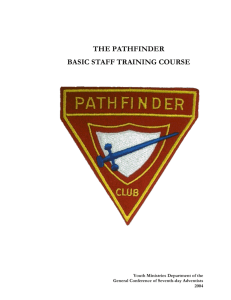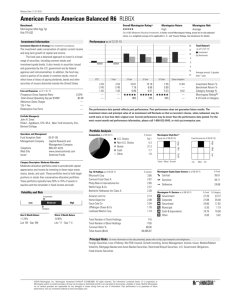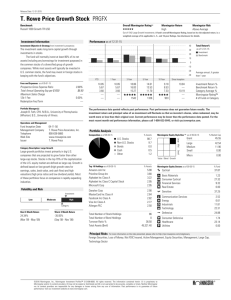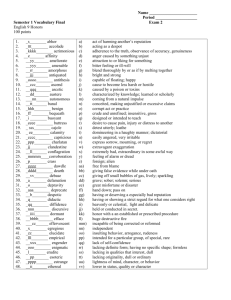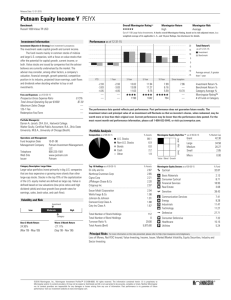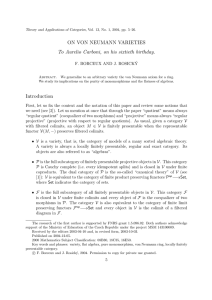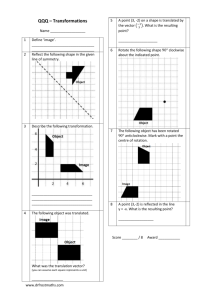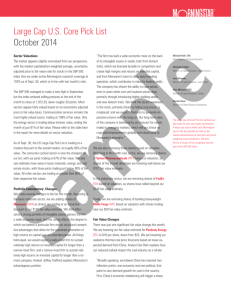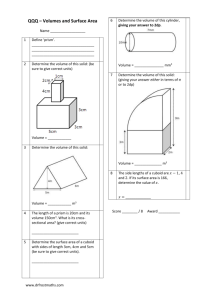PROTOLOCALISATIONS OF EXACT MAL’CEV CATEGORIES FRANCIS BORCEUX, MARINO GRAN, SANDRA MANTOVANI
advertisement
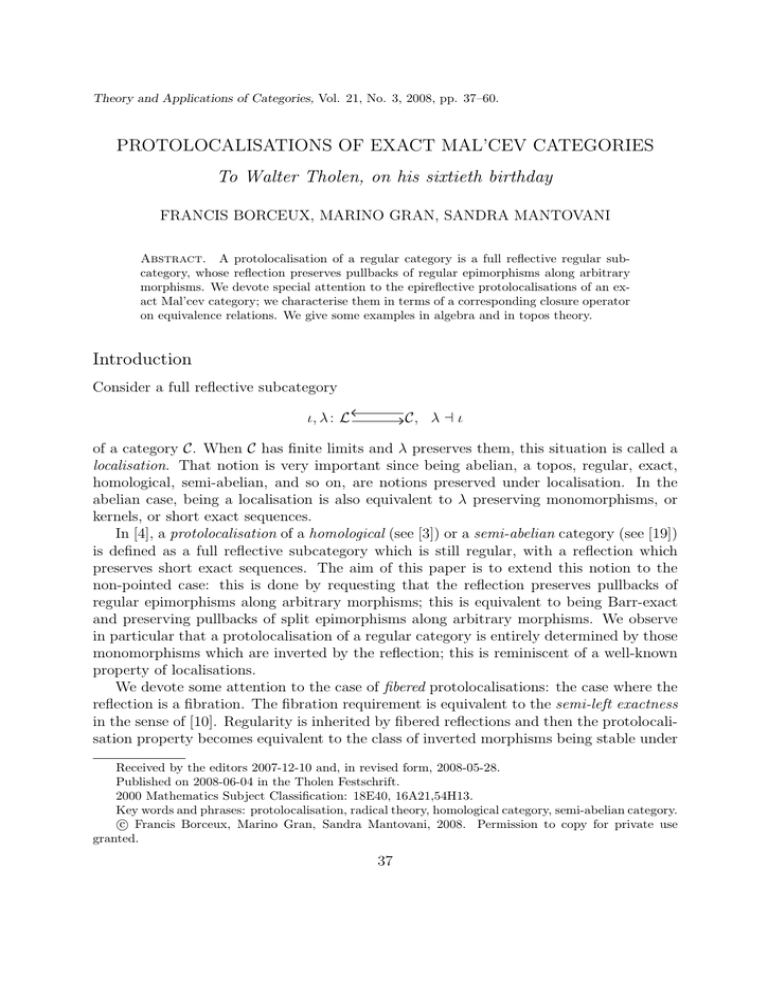
Theory and Applications of Categories, Vol. 21, No. 3, 2008, pp. 37–60.
PROTOLOCALISATIONS OF EXACT MAL’CEV CATEGORIES
To Walter Tholen, on his sixtieth birthday
FRANCIS BORCEUX, MARINO GRAN, SANDRA MANTOVANI
Abstract. A protolocalisation of a regular category is a full reflective regular subcategory, whose reflection preserves pullbacks of regular epimorphisms along arbitrary
morphisms. We devote special attention to the epireflective protolocalisations of an exact Mal’cev category; we characterise them in terms of a corresponding closure operator
on equivalence relations. We give some examples in algebra and in topos theory.
Introduction
Consider a full reflective subcategory
ι, λ : L
qqqq
qqqqqqqqq
qqqq
qqqqq
qqqq
qqq
qqqqq
C, λ a ι
of a category C. When C has finite limits and λ preserves them, this situation is called a
localisation. That notion is very important since being abelian, a topos, regular, exact,
homological, semi-abelian, and so on, are notions preserved under localisation. In the
abelian case, being a localisation is also equivalent to λ preserving monomorphisms, or
kernels, or short exact sequences.
In [4], a protolocalisation of a homological (see [3]) or a semi-abelian category (see [19])
is defined as a full reflective subcategory which is still regular, with a reflection which
preserves short exact sequences. The aim of this paper is to extend this notion to the
non-pointed case: this is done by requesting that the reflection preserves pullbacks of
regular epimorphisms along arbitrary morphisms; this is equivalent to being Barr-exact
and preserving pullbacks of split epimorphisms along arbitrary morphisms. We observe
in particular that a protolocalisation of a regular category is entirely determined by those
monomorphisms which are inverted by the reflection; this is reminiscent of a well-known
property of localisations.
We devote some attention to the case of fibered protolocalisations: the case where the
reflection is a fibration. The fibration requirement is equivalent to the semi-left exactness
in the sense of [10]. Regularity is inherited by fibered reflections and then the protolocalisation property becomes equivalent to the class of inverted morphisms being stable under
Received by the editors 2007-12-10 and, in revised form, 2008-05-28.
Published on 2008-06-04 in the Tholen Festschrift.
2000 Mathematics Subject Classification: 18E40, 16A21,54H13.
Key words and phrases: protolocalisation, radical theory, homological category, semi-abelian category.
c Francis Borceux, Marino Gran, Sandra Mantovani, 2008. Permission to copy for private use
granted.
37
38
FRANCIS BORCEUX, MARINO GRAN, SANDRA MANTOVANI
pullbacks along regular epimorphisms. Fibered protolocalisations are also stable under
slicing.
Of course the most straightforward non-pointed version of homological (resp. semiabelian) categories is the case of regular (resp. exact) protomodular categories (see [8]).
Such categories are in particular Mal’cev categories (see [11]), that is, every reflexive
relation is at once an equivalence relation. We have observed that the Mal’cev axiom is in
fact sufficient for getting all our results concerning protolocalisations: the stronger axiom
of protomodularity can always be avoided.
The case of epireflective protolocalisations of exact Mal’cev categories is worth a special
interest. Such a protolocalisation is always Birkhoff, that is, the reflection is closed under
regular quotients. But more importantly, the protolocalisation is then entirely determined
by a corresponding closure operator on the lattices of equivalence relations (see [5]). The
essential goal of the present paper is to characterise exactly those closure operators on
equivalence relations which correspond to an epireflective protolocalisation.
We provide examples of protolocalisations of exact Mal’cev categories, both in algebra
and in topos theory.
When this makes proofs easier, we freely use Barr’s metatheorem (see [1]) allowing to
develop some specific arguments “elementwise” in a regular category.
1. A review of regular, exact, Mal’cev and Goursat categories
To avoid any ambiguity, let us make clear that as many authors, we define a regular category to be a category with finite limits and pullback stable images (image = factorisation
as a regular epimorphism followed by a monomorphism). A regular category is exact when
moreover, every equivalence relation is effective, that is, is a kernel pair (see [1]).
Let us first recall a well-known Barr–Kock theorem (see [1]).
Theorem. In a regular category, consider a commutative diagram
dS1
p
A
P
S
dS2
h
g Diagram (BK)
(2) f
(1)
R
d1
q
Q
B
R
dR
2
where both lines are exact forks. Then the square (1) is a pullback if and only if one of
the squares (2) is a pullback. In that case, both squares (2) are pullbacks.
1.1.
qqqqq
qqq
qqqq
qqqqq
qqqqq
qqq
qqqq
qqqqq
qqqqq qqqqq
qqqqqqqq
qqqqq qqqqq
qqqqq qqqqq
qq qq
qqqqqqqqqq
qqqqq qqqqq
qqqqqqqq
qqqqq qqqqq
qqqqqqqq
qqqqq
qqq
qqqq
qqqqq
qqqqq
qqqq
qqq
qqqqq
qqqqq qqqqq
qqqqq qqqqq
qq qq
qqqqq qqqqq
Let us also recall that an exact fork in a regular category is a diagram
u
R
v
qqqqq
qqq
qqqq
qqqqq
qqqqq
qqq
qqqq
qqqqq
A
q
qqqqq qqqqq
qqqq qqqq
qqq qqq
qqqqq qqqqq
Q
where q = Coker (u, v) is the coequaliser of u and v while (u, v) is the kernel pair of q. A
Barr-exact functor is one which preserves exact forks.
PROTOLOCALISATIONS OF EXACT MAL’CEV CATEGORIES
39
It is easily observed that, in a regular category, the pullback of two regular epimorphisms is always a pushout:
v
A
qqqqq qqqqq
qqq qqq
qqqq qqqq
qqqqq qqqqq
B
q
p
qqqqq qqqq
qqqqqqqqqqqqqqqqqq
qqqqqqqq
qq qq
qqqqqqqqqqqqqqqqqqqqqqq
qqqqqqqq
C
u
qqqqq qqqqq
qqq qqq
qqqq qqqq
qqqqq qqqqq
D
Indeed by regularity, the factorisation R[q]
R[p] between kernel pairs is a regular
epimorphism, from which it follows that given f ◦ v = g ◦ q, f coequalises the kernel pair
of p.
A Mal’cev category is a category with finite limits in which every reflexive relation is
an equivalence relation. It follows that exact Mal’cev categories are characterised among
regular categories as those in which every reflexive relation is an effective equivalence
relation (see [12]). A further characterisation is given by (see [11]):
qqqqq
qqq
qqqq
qqqqq
1.2. Theorem. A regular category C is an exact Mal’cev category if and only if, given
two regular epimorphisms f : A
B and g : A
C, the pushout (Q, f , g) of f and g
B ×Q C to the pullback of g and f is a regular
exists, and the comparison arrow α : A
epimorphism:
qqqqq qqqqq
qqqqq qqqqq
qq qq
qqqqq qqqqq
qqqqq qqqqq
qqqqq qqqqq
qq qq
qqqqq qqqqq
qqqqq
qqqqq
qq
qqqqq
A pH
p
pp
A p pH
p p HH g
A p p pα
p p p HH
ppp
A
HH
ppp
A
H
H
B
×
C
A
C
Q
f A
A
f
A
A
q
qqq
qqqqqqqqqq
qqq q
qq qqq
qqqqqqqqqqqqqq
qqqqq qqqqqqqqqq
qqqq qqqq
qqq qqq
qqqqq qqqqq
q
q
qq qqqqq qqqqq
qqqqqqqqqqqq qqq qqqqqqqqqqqqqqqqqqqqqqqq
qqqqqqqqqqq
qqqqq qqqqq
qqqqqqqqqqqqqqqqqq
qqqqqqqq
B
qqqqq qqqqq
qqq qqq
qqqq qqqq
qqqqq qqqqq
g
Q
In general, a pushout of regular epimorphisms having the property that the factorisation to the corresponding pullback is a regular epimorphism is called a regular pushout.
Let us observe, in particular, that in every category, a commutative diagram of split
epimorphisms
A
v
qqqqq qqqqq
qqqq qqqq
qqq qqq
qqqqq qqqqq
B
qqqqqqqq
qqqqq qqqqq
qqqqqqqq
qqqqq qqqqq
t q
s
qqqqq qqqqq
qqqqqqqq
C
p
qqqqq qqqqq
qqqqqqqq
u
qqqqq qqqqq
qqqq qqqq
qqq qqq
qqqqq qqqqq
D
40
FRANCIS BORCEUX, MARINO GRAN, SANDRA MANTOVANI
is trivially a pushout as soon as v is an epimorphism. In an exact Mal’cev category, when
u and v are regular epimorphisms, we obtain thus a regular pushout.
A regular category is a Mal’cev category exactly when it is 2-permutable: given two
equivalence relations R and S on the same object A, their relational composites satisfy
the equality R ◦ S = S ◦ R. This property is equivalent to the fact that the join R ∨ S of
any two equivalence relations R and S is given by R ∨ S = R ◦ S.
The property of 3-permutability of the composition of equivalence relations R◦S ◦R =
S ◦ R ◦ S is known to be strictly weaker than the one of 2-permutability, and that it is this
time equivalent to R ∨ S = R ◦ S ◦ R. A regular 3-permutable category is called a Goursat
category (see [11]). Among regular categories, Goursat categories are nicely characterised
by the fact that the regular image f (R) of any equivalence relation R on A along any
B is an equivalence relation on B (see [11] again). It is
regular epimorphism f : A
also true that the lattice of equivalence relations on any object is necessarily a modular
lattice, a property which no longer holds for the n-permutable categories, when n ≥ 4.
A variety of universal algebras is a Mal’cev category if and only if its theory has a
ternary (possibly derived) term p(x, y, z) satisfying the axioms
qqqqq qqqqq
qqqq qqqq
qqq qqq
qqqqq qqqqq
p(x, x, y) = y,
p(x, y, y) = x
(see [24]). Any variety whose theory is equipped with a group operation is thus a Mal’cev
variety, since in that case it suffices to set p(x, y, z) = xy −1 z. The variety of Heyting
algebras is also a Mal’cev variety (see [21]), so that the dual category of an elementary
topos is an exact Mal’cev category (see [11]). Another class of examples of exact Mal’cev
categories arises from the compact Hausdorff models T(HComp) of a Mal’cev theory T.
On the other hand, for a given variety, the Goursat property is equivalent to the
existence of two ternary operations p(x, y, z) and q(x, y, z) such that
p(x, x, y) = y,
q(x, y, y) = x,
p(x, y, y) = q(x, x, y),
as shown in [18]. Implication algebras form a 3-permutable variety, which is not 2permutable: recall that these algebras are equipped with a binary operation . satisfying
the identities
(x . y) . y = (y . x) . x,
(x . y) . x = x,
x . (y . z) = y . (x . z).
2. The protolocalisations
Let us now introduce the main notion of this paper.
2.1. Definition. A protolocalisation of a regular category C is a full reflective subcategory
C; λ : C
L; λ a ι,
ι: L
qqqqq
qqqq
qqq
qqqqq
such that:
qqqqq
qqqq
qqq
qqqqq
qqqqq
qqqq
qqq
qqqqq
PROTOLOCALISATIONS OF EXACT MAL’CEV CATEGORIES
41
1. L is still regular;
2. λ preserves the pullback of a regular epimorphism along an arbitrary morphism.
qqqq
qqqqqqqqq
qqqq
In the abelian case, given a full reflective subcategory ι, λ : L
C, λ being Barr-exact
is equivalent by additivity to λ being exact, that is, preserving short exact sequences; this
is further equivalent to λ preserving all finite limits. Such a situation is called a localisation. But already in the semi-abelian case these equivalences no longer hold: preserving
short exact sequences is stronger than being Barr-exact and weaker than preserving finite
limits (see [4]). Our Proposititon 2.2 measures the gap between these two definitions of exactness. This statement is of course highly reminiscent of the definition of a protomodular
category (see [8]).
qqqq
qqqqqqqqq
qqqq
qqqqq
qqq
qqqq
qqqqq
C be a full reflective and regular subcategory of a
2.2. Proposition. Let ι, λ : L
regular category C. The following conditions are equivalent:
qqqqq
qqqq
qqq
qqqqq
1. λ is a protolocalisation;
2. the following two properties hold:
(a) λ is Barr-exact;
(b) λ preserves the pullback of a split epimorphism along an arbitrary morphism.
Proof. (1 ⇒ 2) is trivial. Conversely, consider Diagram (BK) where the square (1) is
a pullback. All four morphisms dSi and dR
i are epimorphisms split by the diagonal. By
assumption, exact forks and both pullbacks (2) are preserved by λ. Theorem 1.1 implies
that λ(1) is a pullback as well.
2.3. Corollary. Let C be a homological category. The two notions of protolocalisation
in Definition 2.1 of this paper and in Definition 17 of [4] are equivalent.
Proof. Proposition 19 in [4] shows that the definition in that paper implies our Definition 2.1. Conversely in the pointed case, our Proposition 2.2 forces the preservation of
the kernel of a regular epimorphism, since this kernel is given by the pullback over the
zero object.
Let us also mention that
2.4.
Proposition. A protolocalisation of an exact category is still exact.
Proof. This follows from Theorem 7 in [4].
42
FRANCIS BORCEUX, MARINO GRAN, SANDRA MANTOVANI
Let us next recall that an object L ∈ C is orthogonal to a morphism h ∈ C when for
every morphism f as in the following diagram
h
A
f
qqqqq qqqqq
qqqqqqqq
ppp
qqqq
qqqqqqqqqq
ppp
ppp g
p
p
pp
qqqqq
qqq
qqqq
qqqqq
pp
ppp
pp
B
L
there exists a unique morphism g making the triangle commutative.
The following result is well-known in the case of a localisation (see [10]). Our more
general version applies clearly to the case of a protolocalisation of a regular category.
qqqq
qqqqqqqqq
qqqq
2.5. Proposition. Let ι, λ : L
C be a full reflective subcategory of a regular category
C. When the reflection λ is Barr-exact, the full subcategory L is that of those objects of
C orthogonal to the monomorphisms inverted by λ.
qqqqq
qqqq
qqq
qqqqq
Proof. It is well-known (see [15]) that being in L is equivalent to being orthogonal to
ιλ(A), the unit of
all morphisms h inverted by λ, or simply orthogonal to each ηA : A
the adjunction, for all A ∈ C. This proves already that each L ∈ L is orthogonal to every
monomorphism inverted by λ.
Conversely, assume that L is orthogonal to every monomorphism inverted by λ; we
shall prove that L is orthogonal to each ηA . For that we consider the following diagram
uA
ηA
δA
ιλ(A)
RA
A H
A
p
pppp
p
vA
p
p
h
H pA
p
p
p
p
HH
pppp
sA
f
pppp
p pH
qqqqq
qqq
qqqq
qqqqq
qqqqq
qqqq
qqq
qqqqq
qqqqq
qqqq
qqq
qqqqq
qqqqq
qqqqq
qq
qqqqq
qqqqq
qqq
qqqq
qqqqq
qqqqq
qqqq
qqq
qqqqq
qqqqqqq
qqqqq qqqqq
p p p HH
pppp
p
H
p
p
ppp
H
gp p p p p p p p p p p p pH
p
p
p
p
p
p
p
p
p
p
p
p
p
p
p p p p SA
L
qqqqq qqqq
qqqqqqqq
qqq
qqqqqqqqqqq
qqqq
qqqqqqqqq
qqqq
qqq q
qq qqq
qqqqqqqqqqqqqqqqqqq
qqqqqqq
qqqqq qqqqq
where ηA = sA ◦ pA is the image factorisation of ηA , (uA , vA ) is the kernel pair of pA and
δA is the diagonal of this kernel pair.
Since λ(ηA ) is an isomorphism, the regular epimorphism λ(pA ) is also a monomorphism, thus an isomorphism. Thus λ(sA ) is an isomorphism as well. On the other hand
the reflection λ preserves the exact fork (uA , vA ; pA ). Since λ(pA ) is an isomorphism, so
are thus λ(uA ) and λ(vA ), but then also λ(δA ), which is their right inverse.
Now let L ∈ C be orthogonal to every monomorphism inverted by λ. Consider a
morphism f : A
L. Since f ◦ uA ◦ δA = f = f ◦ vA ◦ δA , we obtain f ◦ uA = f ◦ vA by
the uniqueness part of the orthogonality condition δA ⊥ L. But pA = Coker (uA , vA ), from
which there is a unique factorisation g : SA
L such that g ◦ pA = f . The orthogonality
condition sA ⊥ L forces finally the existence of a unique morphism h : ιλ(A)
L such
that h ◦ sA = g.
qqqqq
qqqq
qqq
qqqqq
qqqqq
qqqq
qqq
qqqqq
qqqqq
qqq
qqqq
qqqqq
PROTOLOCALISATIONS OF EXACT MAL’CEV CATEGORIES
43
3. The fibered case
qqqq
qqqqqqqqq
qqqq
Given a full reflective subcategory ι, λ : L
C of a category C with finite limits, let us
write E for the class of those morphisms of C inverted by λ and M for the class of those
morphisms of C orthogonal to all morphisms in E. This means that m ∈ M when in every
commutative square with e ∈ E
e
•
qqqqq qqqq
qqqqqqqq
•
qqqqq
qqq
qqqq
qqqqq
ppp
qq
qqqqqqqqqqqq
p
pp
ppp
ppp
m
qqqqq
qqqq
qqq
qqqqq
pp
pp
ppp
p•
qqqqq qqqq
qqqqqqqq
qqqqq
qqqq
qqq
qqqqq
•
there exists a unique diagonal making both triangles commutative. The pair (E, M) is
a prefactorisation system; it is a factorisation system when moreover each arrow f ∈ C
factors (necessarily uniquely) as f = m ◦ e, with e ∈ E and m ∈ M (see [10]).
3.1. Definition. By a fibered reflection of a category C with finite limits is meant a
C such that λ is a fibration (see [7, 9]).
full reflective subcategory ι, λ : L
qqqq
qqqqqqqqq
qqqq
qqqqq
qqqq
qqq
qqqqq
3.2. Proposition. Consider a full reflective subcategory ι, λ : L
with finite limits. The following conditions are equivalent:
qqqq
qqqqqqqqq
qqqq
qqqqq
qqq
qqqq
qqqqq
C of a category C
1. the reflection is fibered;
2. the reflection is semi-left-exact in the sense of [10].
In these conditions, the corresponding prefactorisation system (E, M) is a factorisation
system and λ preserves the pullbacks along morphisms of M.
Proof. The proof of Proposition 36 in [4] applies without any change to prove the equivalence. The rest follows from [10].
As a consequence (see [22]):
3.3.
Corollary. A fibered reflection of a regular category is still regular.
Proof. By Theorem 4 in [4], it suffices to prove that λ preserves “some” pullbacks along
the morphisms of L. Since all morphisms in L are in particular in M (see [10]), the result
follows at once from Proposition 3.2.
qqqq
qqqqqqqqq
qqqq
3.4. Proposition. Let ι, λ : L
C be a fibered reflection of a regular category C. The
following conditions are equivalent:
qqqqq
qqq
qqqq
qqqqq
1. the reflection is a protolocalisation;
2. the class E of those morphisms inverted by λ is stable under pullbacks along regular
epimorphisms.
44
FRANCIS BORCEUX, MARINO GRAN, SANDRA MANTOVANI
Proof. (1 ⇒ 2) simply because λ preserves pullbacks along regular epimorphisms. Conversely, by Corollary 3.3, we know already that L is regular. Next consider the following
diagram
f0
A
e0
h0
qqqqq
qqq
qqqq
qqqqq
qqqqq qqqqq
qqqqqqqq
m0
C
qqqqq
qqqq
qqq
qqqqq
h00
qqqqq qqqqq
qqqqqqqqqqqqqqqqqq
qqqqqqqq
X
h
qqqqq qqqqq
qqqqqqqqqqqqqqqqqq
qqqqqqqq
e
qqqqq
qqq
qqqq
qqqqq
B
qqqqq qqqqq
qqqqqqqqqqqqqqqqqq
qqqqqqqq
Z
qqqqq
qqq
qqqq
qqqqq
m
Y
qqqqqqq
qqqqq qqqqq
f
where the outer part is a pullback, with h a regular epimorphism. We split this pullback
in two pieces along the (E, M)-factorisation f = m ◦ e of f . The reflection λ preserves
the left hand pullback by assumption and the right hand pullback by Proposition 3.2.
Let us also observe that fibered protolocalisations are stable under slicing:
3.5. Proposition. Every fibered protolocalisation ι, λ : L
induces, for every object I ∈ C, a fibered protolocalisation
ιI , λI : L/λ(I)
qqqq
qqqqqqqqq
qqqq
qqqqq
qqqq
qqq
qqqqq
qqqq
qqqqqqqqq
qqqq
qqqqq
qqqqq
qq
qqqqq
C of a regular category C
C/I.
Proof. The existence of the adjunction λI a ιI is well-known (see [6], Lemma 4.3.4). Let
us simply recall that
λ(f )
f
λI C
I = λ(C)
λ(I)
0
while ιI L g λ(I) = L0 g I is obtained via the pullback
qqqqq
qqqq
qqq
qqqqq
qqqqq
qqqqq
qq
qqqqq
qqqqq
qqq
qqqq
qqqqq
qqqqq
qqqqq
qq
qqqqq
L0
qqqqq
qqqq
qqq
qqqqq
g0
g
qqqqq qqqqq
qqqqqqqq
I
L
qqqqq qqqqq
qqqqqqqq
ηI
qqqqq
qqq
qqqq
qqqqq
λ(I)
where ηI is the unit of the adjunction λ a ι.
By semi-left exactness of λ (see Proposition 3.2), the upper morphism in this square
is itself a unit (see [10]), thus is isomorphic to ηL0 . But this forces
g0
g
g
λ(I) ∼
I ∼
λ(I)
λ I ιI L
= λI L0
= L
qqqqq
qqqq
qqq
qqqqq
qqqqq
qqqq
qqq
qqqqq
qqqqq
qqqq
qqq
qqqqq
proving that the counit of the adjunction is an isomorphism. Therefore ιI is full and
faithful.
The slice categories of a regular category are still regular and both pullbacks and regular epimorphisms are computed in the slice category as in the original category. Therefore
λI preserves pullbacks along regular epimorphisms, since so does λ.
45
PROTOLOCALISATIONS OF EXACT MAL’CEV CATEGORIES
4. The case of epireflections
By an epireflection of a regular category we mean a reflection having regular epimorphic
units. Let us recall at once that an epireflection of a regular category is itself a regular
category (see [4], Example 11). But moreover:
4.1.
Proposition. Every epireflective protolocalisation of a regular category is fibered.
Proof. The pullback of a unit of the adjunction is now the pullback of a regular epimorphism, thus is preserved by the reflection. Therefore the reflection is semi-left exact (see
[10]) and thus fibered (see Proposition 3.2).
4.2. Proposition. Given an epireflection ι, λ : L
inclusion functor ι : L
C is Barr-exact.
qqqq
qqqqqqqqq
qqqq
qqqqq
qqqq
qqq
qqqqq
C of a regular category C, the
qqqqq
qqqqq
qq
qqqqq
Proof. As a right adjoint, the functor ι preserves kernel pairs. The image factorisation
in C of a regular epimorphism of L lies entirely in L, since an epireflection is closed under
subobjects. Thus the mono-part of the factorisation is an isomorphism and ι preserves
regular epimorphisms.
4.3. Proposition. Given an epireflective protolocalisation ι, λ : L
category C,
qqqq
qqqqqqqqq
qqqq
qqqqq
qqqqq
qq
qqqqq
C of a regular
1. λ fixes the terminal object 1;
2. λ fixes the subobjects of 1;
3. λ preserves finite products.
Proof. First of all, ι preserves the terminal object, proving that the terminal object of
C lies in L. Since we have an epireflection and 1 ∈ L, every subobject of 1 is also in L.
The product of two objects is their pullback over 1. Via the image factorisations of
the morphisms to 1, this pullback can be split in four pullback pieces
A×B
qqqqq qqqqq
qqqq qqqq
qqq qqq
qqqqq qqqqq
qq qq
qqqqqqqqqqqqqqqqqqqqqqqq
qqqqqqqq
•
•
qqqqq
qqqq
qqq
qqqqq
qqqqq
qqqq
qqq
qqqqq
qqqqq
qqqq
qqq
qqqqq
qqqqq
qqqq
qqq
qqqqq
qq qq
qqqqqqqqqqqqqqqqqqqqqqqq
qqqqqqqq
qqqqq qqqqq
qqqq qqqq
qqq qqq
qqqqq qqqqq
•
qqqqq qqqq
qqqqqqqq
qqqqq qqqq
qqqqqqqq
qqqqq qqqqq
qqqqqqqq
qqqqq qqqqq
qqqqqqqq
A
qqqqq qqqqq
qqqqqqqqqqqqqqqqqq
qqqqqqqq
•
qqqqq qqqq
qqqqqqqq
(∗)
B
qqqqq qqqqq
qqqq qqqq
qqq qqq
qqqqq qqqqq
•
qqqqq qqqqq
qqqqqqqq
qqqqq
qqqq
qqq
qqqqq
qqqqq
qqqq
qqq
qqqqq
1
Each partial pullback is preserved by λ: (∗) because it is fixed by λ and the other ones
by definition of a protolocalisation.
46
FRANCIS BORCEUX, MARINO GRAN, SANDRA MANTOVANI
Let us also recall that
4.4. Definition. An epireflection ι, λ : L
L is stable in C under regular quotients.
qqqq
qqqqqqqqq
qqqq
qqqqq
qqqqq
qq
qqqqq
C of a regular category C is Birkhoff when
In the case of algebraic theories, the Birkhoff epireflections are those obtained by
adding axioms to a theory.
4.5. Proposition. An epireflective protolocalisation ι, λ : L
C is necessarily Birkhoff.
Proof. Consider a regular epimorphism q : L
(u, v), yields the diagram
u
R
qqqqq
qqqqq
qq
qqqqq
qqqqq
qqq
qqqq
qqqqq
v
q
ιλ(u)
qqqqq
qqqqq
qq
qqqqq
qqqqq
qqq
qqqq
qqqqq
qqqqq
qqq
qqqq
qqqqq
C of a regular category
C in C, with L ∈ L. Its kernel pair
qqqqq qqqqq
qqq qqq
qqqq qqqq
qqqqq qqqqq
ηL ∼
=
ηR
qqqqq qqqqq
qqqqqqqqqqqqqqqqqq
qqqqqqqq
L
qqqqq qqqqq
qqqqq qqqqq
qq qq
qqqqq qqqqq
qqqq
qqqqqqqqq
qqqq
C
ηC
qqqqq qqqqq
qqqqqqqqqqqqqqqqqq
qqqqqqqq
qqqqq qqqqq
qqqqqqqq
qqqqq qqqqq
qqq qqq
qqqq qqqq
qqqqq qqqqq
ιλ(C)
ιλ(q)
ιλ(v)
The pair (u, v) is monomorphic and ηL is an isomorphism, thus ηR is a monomorphism
and therefore an isomorphism.
Since ι preserves kernel pairs, the bottom line remains a kernel pair, by the protolocalisation axiom. But ιλ(q) is a regular epimorphism in C, since so are q and ηC . Thus
both lines are exact forks and ηC is an isomorphism, since so are ηR and ηL .
ιλ(R)
ιλ(L)
5. The case of exact Mal’cev categories
We want now to study the protolocalisations in terms of closure operators on equivalence
relations. For this we need to switch first to the exact Goursat case and finally to the
exact Mal’cev case. The following theorem is proved in [5].
5.1.
Theorem. For an exact Goursat category C, there is a bijection between:
• the Birkhoff epireflections ι, λ : L
qqqq
qqqqqqqqq
qqqq
qqqqq
qqqq
qqq
qqqqq
C;
• the operators associating, with every equivalence relation S on an object B, another equivalence relation S on B, and satisfying the following properties for S, T
equivalence relations on B, f : A
B and g : B
C morphisms of C:
qqqqq
qqqq
qqq
qqqqq
qqqqq
qqqq
qqq
qqqqq
[CL1] S ⊆ S;
[CL2] S = S;
[CL3] S ⊆ T implies S ⊆ T ;
[CL4] f −1 (S) ⊆ f −1 (S);
[CL5] f −1 (S) = f −1 (S) when f is a regular epimorphism;
PROTOLOCALISATIONS OF EXACT MAL’CEV CATEGORIES
47
[CL6] g(S) = g(S) when g is a regular epimorphism.
Via this correspondence, the reflection of an object B ∈ C is given by
ηB : B
qqqqq qqqqq
qqqq qqqq
qqq qqq
qqqqq qqqqq
B/∆B .
The closure of an equivalence relation S on B is given by
qS−1 R[ηB/S ] = R ηB/S ◦ qS
where qS : B
B/S is the quotient map and R[•] indicates a kernel pair. This closure
is also equal to
S = S ∨ ∆B
qqqqq qqqqq
qqqq qqqq
qqq qqq
qqqqq qqqqq
where ∨ indicates the supremum in the lattice of equivalence relations on B and ∆B
indicates the diagonal.
With the terminology of [5], axioms [CL1], [CL3] and [CL4] are those for a closure
operator on equivalence relations. In this statement, we have used freely the classical
notation f −1 (R) to indicate (f × f )−1 (R) and analogously, g(R) for the direct image of R
along the regular epimorphism g × g. Notice that the inverse image of an equivalence relation is always an equivalence relation, while the direct image along a regular epimorphism
is an equivalence relation precisely when the Goursat axiom holds (see [16]).
Our purpose is now to investigate the form of the additional axiom which will force
a Birkhoff epireflection to become a protolocalisation. Our first characterisation theorem
is:
5.2. Theorem. Consider a Birkhoff epireflection ι, λ : L
egory C. The following conditions are equivalent:
qqqq
qqqqqqqqq
qqqq
qqqqq
qqq
qqqq
qqqqq
C of an exact Goursat cat-
1. the reflection λ is Barr-exact;
2. for every equivalence relation r : R
qqqqq
qqqqq
qq
qqqqq
qqqqq
qqqqq
qq
qqqqq
A × A in C, one has ∆R = r−1 ∆A × ∆A .
Moreover, in these conditions, the reflection preserves finite powers.
Proof. Consider the diagram
qqqqq
qqq
qqqq
qqqqq
qqqqq
qqq
qqqq
qqqqq
∆R
pp
pp
pp
pp
pp
pp
ηR
qqqqq qqqqq
qqqq qqqq
qqq qqq
qqqqq qqqqq
ιλ(R)
qqqqq qqqqq
qqqqqqqq
r = (d1 , d2 )
qqqqq qqqqq
qqqqqqqq
∆A × ∆A
R
qqqqq qqqqq
qqqqqqqq
qqqqq
qqqq
qqq
qqqqq
qqqqq
qqqqq
qq
qqqqq
pp
pp
pp
pp s = ιλ(d1 ), ιλ(d2 )
pp
pp
qqqqq qqqqq
qqqqqqqq
A × A η × η ιλ(A) × ιλ(A)
A
A
qqqqq qqqqq
qqqq qqqq
qqq qqq
qqqqq qqqqq
48
FRANCIS BORCEUX, MARINO GRAN, SANDRA MANTOVANI
where both lines are exact forks. An easy chase on this diagram shows that s is a monomorphism if and only if ∆R = r−1 ∆A × ∆A .
If the reflection preserves exact forks, s = ιλ(d1 ), ιλ(d2 ) is a kernel pair, thus a
monomorphism. We have seen that this forces
condition 2. Conversely as already observed, condition 2 forces s = ιλ(d1 ), ιλ(d2 ) to be a monomorphism. But since ηR is
a regular epimorphism, the subobject ιλ(R) = ηR (R) is an equivalence relation by the
Goursat axiom; further, by exactness, it is thus a kernel pair. So λ preserves the fact of
being a kernel pair. Since λ, as a left adjoint, preserves also the coequaliser of a kernel
pair, it is Barr-exact.
When these equivalent conditions are satisfied, choose R = A × A in the argument
above. This forces ∆A×A = ∆A × ∆A and thus ιλ(A × A) ∼
= ιλ(A) × ιλ(A).
As a consequence, the closure operation can also be described by the well-known
construction valid in the case of a localisation:
qqqq
qqqqqqqqq
qqqq
C of an exact
5.3. Corollary. Consider a Barr-exact Birkhoff epireflection ι, λ : L
Goursat category C. The closure of an equivalence relation R on B is also given by the
following pullback:
qqqqq qqqqq
qqq qqq
qqqq qqqq
qqqqq qqqqq
R
qqqqq
qqqq
qqq
qqqqq
ιλ(R)
qqqqq qqqqq
qqqqqqqq
qqqqq qqqqq
qqqqqqqq
ιλ(r)
r
qqqqq qqqqq
qqqqqqqq
qqqqq qqqqq
qqqqqqqq
B × Bη × η ιλ(B) × ιλ(B)
B
B
qqqqq qqqqq
qqq qqq
qqqq qqqq
qqqqq qqqqq
Proof. By Theorem 5.2 the statement makes sense. By Proposition 4.2, the composite
ιλ is still Barr-exact. Applying it to the exact fork
d1
qqqqq
qqqq
qqq
qqqqq
qqqqq
qqqq
qqq
qqqqq
qR
B/R
d2
we get that ιλ(R) is the kernel pair of ιλ(qR ). Thus the pullback in the diagram yields
the kernel pair of ιλ(qR ) ◦ ηB , which is precisely R.
R
B
qqqqq qqqqq
qqq qqq
qqqq qqqq
qqqqq qqqqq
Our next result emphasises the role of a property which is well-known for universal
closure operators.
5.4. Theorem. Consider a Birkhoff epireflection ι, λ : L
egory C. The following conditions are equivalent:
qqqq
qqqqqqqqq
qqqq
qqqqq
qqq
qqqq
qqqqq
C of an exact Mal’cev cat-
1. λ preserves the pullback of two regular epimorphisms;
2. given two equivalence relations R, S on an object B ∈ C, R ∧ S = R ∧ S.
Of course in these conditions, λ is Barr-exact.
PROTOLOCALISATIONS OF EXACT MAL’CEV CATEGORIES
49
Proof. (1 ⇒ 2). By exactness, the lattice of equivalence relations on B is isomorphic to
the lattice of regular quotients of B. Moreover, writing qT for the quotient of B by an
equivalence relation T , one has always the following diagram of regular epimorphisms
B H
A@ HH
A @ HHqS
A @qR∧S HH
HH
A @
H
qRAB/(R ∧ S) pS B/S
A
A
pR (∗)
tS
A
A
qqq q
qqqqqqqqqqqqqqqqqqqqqqqq
qqq q
qq qqq
qqqqqqqqqqqqqq
qqqqq qqqqq qqqqq
qqqqq qqqqq
qq qq
qqqqq qqqqq
qq qqqqqq qqqqq
qqqqqqqqqqqqqqqqqqqqqqqqqqqqqqqqqqqqqqqqq
qqqqqqqqqqq
B/R
qqqqq qqqqq
qqqqqqqqqqqqqqqqq
qqqqqqqq
qqqqq qqqqq
qqqq qqqq
qqq qqq
qqqqq qqqqq
tR
B/(R ∨ S)
where the outside part is trivially a pushout. By Theorem 1.2, the factorisation of this
pushout through the pullback of tR and tS is still a regular epimorphism: then trivially,
this pullback must be B/(R ∧ S). In other words, in the diagram above, the square (∗) is
a pullback.
The pullback (∗) is preserved by the reflection λ, since it is constituted of regular
epimorphisms. We obtain so a new commutative diagram, where η indicates the unit of
the adjunction and the square is still a pullback.
B
ηB
qqqqq qqqqq
qqqqq qqqqq
qq qq
qqqqq qqqqq
ιλ(B)
HH
A@ HH
H
A@
HHιλ(qS )
A @
H
@
H
A
ιλ(q
R∧S )HH
@
A
H
@
H
A
H
ιλ
B/S
ιλ
B/(R
∧
S)
A
ιλ(qR ) A
ιλ(pS )
A
A
ιλ(pR )
ιλ(tS )
A
A
AA
q
qqq qq
qqqqqqqqqqqqqqqqqqqqqq
qqq q
qq qqq
qqqqqqqqqqqqqqqqqqq
qqqqq qqqqq
qqqq qqqq
qqq qqq
qqqqq qqqqq
qqq qqq
qq q qqqqq qqqqq q
qqqqqqqqqqqq qqqq qqqqqqqqqqqqqqqqqq
qqqqqqqqqqq
ιλ B/R
qq qq
qqqqqqqqqqqqqqqqqqqqqqqq
qqqqqqqq
qqqqq qqqqq
qqq qqq
qqqq qqqq
qqqqq qqqqq
ιλ(tR )
ιλ B/(R ∨ S)
Since the diagram is commutative and the pair ιλ(pR ), ιλ(pS ) is monomorphic, the
kernel pair of ιλ(qR∧S ) ◦ ηB is the intersection of the kernel pairs of ιλ(qR ) ◦ ηB and
ιλ(qS ) ◦ ηB . This means precisely R ∧ S = R ∧ S.
(2 ⇒ 1). Consider the pullback (?) of two regular epimorphisms f , g in C and its
image by ιλ.
50
FRANCIS BORCEUX, MARINO GRAN, SANDRA MANTOVANI
B
b
a
qqqqq qqqqq
qqqqq qqqqq
qq qq
qqqqq qqqqq
qqqqq qqqqq
qqqqq qqqqq
qq qq
qqqqq qqqqq
g
(?)
qq qq
qqqqqqqqqqqqqqqqqqqqqqqq
qqqqqqqq
D
ιλ(B) ιλa ιλ(A)
A
ιλ(b)
qqqqq qqqqq
qqqqqqqqqqqqqqqqqq
qqqqqqqq
f
qqqqq qqqqq
qqqq qqqq
qqq qqq
qqqqq qqqqq
ιλ(?)
qq qq
qqqqqqqqqqqqqqqqqqqqqqqq
qqqqqqqq
ιλ(g)
qq qq
qqqqqqqqqqqqqqqqqqqqqqqq
qqqqqqqq
qqqqq qqqqq
qqq qqq
qqqq qqqq
qqqqq qqqqq
ιλ(D)
ιλ(C)
ιλ(f )
C
In a regular category, the pullback of two epimorphisms is also a pushout, proving that
(?) and thus λ(?) are pushouts. The pushout in C of ιλ(a) and ιλ(b) is a quotient of
ιλ(A); by the Birkhoff axiom, it lies in L. Thus the pushout in C is also the pushout in
L. In other words, ιλ(?) is a pushout in C.
But in the exact Mal’cev category C, Theorem 1.2 implies that the factorisation
α : ιλ(B)
qqqqq qqqqq
qqqqq qqqqq
qq qq
qqqqqqqqqq
ιλ(A) ×ιλ(C) ιλ(D)
through the pullback is a regular epimorphism. If we prove that α is an isomorphism,
then ιλ(?) will be a pullback, thus λ(?) as well. Of course, it suffices to prove that α is a
monomorphism.
Writing R[•] to indicate a kernel pair, we must prove that R[α] is the diagonal. Since
ηB is a regular epimorphism, this is equivalent to prove that R[α ◦ ηB ] = R[ηB ]. By
definition of a pullback, R[a] ∧ R[b] = ∆B , thus
R[ηB ] = ∆B = R[a] ∧ R[b].
On the other hand, considering analogously the monomorphic pair constituted of the two
projections of the pullback ιλ(A) ×ιλ(C) ιλ(D), we get
R[α ◦ ηB ] = R[ιλ(a) ◦ ηB ] ∧ R[ιλ(b) ◦ ηB ] = R[ηA ◦ a] ∧ R[ηD ◦ b] = R[a] ∧ R[b].
By assumption, this yields the result.
Let us recall that a category is arithmetical when it is exact, Mal’cev and its lattices
of equivalence relations are distributive (see [23]).
qqqq
qqqqqqqqq
qqqq
5.5. Corollary. Consider a Birkhoff epireflection ι, λ : L
C of an arithmetical category C. The functor λ always preserves the pullback of two regular epimorphisms.
Proof. It is proved in [5], Proposition 3.13, that under our assumptions f R ∧ S =
f (R) ∧ f (S) for every regular epimorphism f . One concludes by choosing f to be the
identity and applying Theorem 5.4.
qqqqq
qqqq
qqq
qqqqq
Let us now introduce a notion which will prove to be an adequate substitute for the
notion of normal subobject, in the absence of a zero object.
5.6. Definition. In a category C with finite limits, a monomorphism f : A
B is
saturated for an equivalence relation R on B when the following diagram is a pullback
qqqqq
qqq
qqqq
qqqqq
qqqqq
qqq
qqqq
qqqqq
51
PROTOLOCALISATIONS OF EXACT MAL’CEV CATEGORIES
f −1 (R)
qqqqq
qqqqq
qq
qqqqq
qqqqq
qqqqq
qq
qqqqq
R
d1
d1
qqqqq qqqqq
qqqqqqqqqqqqqqqqqq
qqqqqqqq
A
qq qq
qqqqqqqqqqqqqqqqqqqqqqqq
qqqqqqqq
qqqqq
qqqq
qqq
qqqqq
f
qqqqq
qqqq
qqq
qqqqq
B
Written elementwise, this condition means
a ∈ A, (a, b) ∈ R ⇒ b ∈ A.
Of course the “elementwise” description is exactly the usual notion of a subset saturated for an equivalence relation. Notice also that in the pointed case, the equivalence
class of 0 ∈ A is always saturated: thus kernel subobjects are special instances of saturated
subobjects.
We have then:
qqqq
qqqqqqqqq
qqqq
C be a Birkhoff epireflection of an exact Mal’cev category.
5.7. Theorem. Let ι, λ : L
The following conditions are equivalent:
qqqqq
qqqq
qqq
qqqqq
1. λ is a protolocalisation;
2. the corresponding closure operator satisfies the additional axiom:
[CL7] f −1 (R) ∧ f −1 (S) = f −1 (R ∧ S)
for two equivalence relations R, S on B and a subobject f : A
for R.
qqqqq
qqqq
qqq
qqqqq
qqqqq
qqqq
qqq
qqqqq
B saturated
Proof. (1 ⇒ 2). Notice that the inclusion
f −1 (R ∧ S) ⊆ f −1 (R) ∧ f −1 (S)
always holds, simply because
f −1 (R ∧ S) ⊆ f −1 (R),
f −1 (R ∧ S) ⊆ f −1 (S) ⊆ f −1 (S).
For the other inclusion, consider (a, a0 ) ∈ f −1 (R) ∧ f −1 (S). We have thus
a00 ∈ A, (a, a00 ) ∈ R, (a00 , a0 ) ∈ ∆A ,
b ∈ B, (a, b) ∈ S, (b, a0 ) ∈ ∆B .
Since f −1 (R) ⊆ f −1 (R), we have by Theorem 5.4
(a, a0 ) ∈ R ∧ S = R ∧ S = (R ∧ S) ∨ ∆B = (R ∧ S) ◦ ∆B = ∆B ◦ (R ∧ S).
This means the existence of
c ∈ B, (a, c) ∈ R ∧ S, (c, a0 ) ∈ ∆B .
52
FRANCIS BORCEUX, MARINO GRAN, SANDRA MANTOVANI
By saturation of A for R, we get c ∈ A. But then since both (a00 , a) and (a, c) are in R,
we obtain
(a00 , c) ∈ f −1 (R) ∧ f −1 (∆B ) ⊆ ∆A .
And
(a, c) ∈ R ∧ S, (c, a00 ) ∈ ∆A , (a00 , a0 ) ∈ ∆A ⇒ (a, a0 ) ∈ f −1 (R ∧ S).
(2 ⇒ 1). Notice first that putting f = idB in condition 2, we obtain R ∧ S = R ∧ S for
every two equivalence relations on B. Thus Theorem 5.4 applies and it remains to consider
the case of pulling back a regular epimorphism along a monomorphism. In Diagram (BK),
assume thus that the square (1) is a pullback, with g a monomorphism; we must prove
that λ(1) is a pullback. Since λ is Barr-exact by Theorem 5.4, this is equivalent to proving
that ιλ(2) is a pullback.
Since g is a monomorphism, a chase on Diagram (BK) proves that S = f −1 (R). Since
the squares (2) are pullbacks, f is saturated for R and the assumption 2 of the statement
applies. Let us prove that the square ιλ(2) — let us say, for the index 1 — is a pullback.
The Barr-exactness of λ allows us to apply Theorem 5.2. We write f as a canonical
inclusion.
An element of ιλ(S) has the form ηA (a), ηA (a0 ) for some (a, a0 ) ∈ S. It is mapped
by ιλ(d1 ) on ηA (a) and by ιλ(h) on ηA (a), ηA (a0 ) . But two elements x, y of an object
X are identified in ιλ(X) when (x, y) ∈ ∆X . And by Theorem 5.2, given an equivalence
relation T on X and two pairs (x, y) ∈ T , (x0 , y 0 ) ∈ T ,
(x, y), (x0 , y 0 ) ∈ ∆T ⇔ (x, x0 ) ∈ ∆X , (y, y 0 ) ∈ ∆X .
To prove that ιλ(2) is a pullback, we must first prove that two elements in ιλ(A) and
ιλ(R) which agree in ιλ(B) come from an element of ιλ(S). This means
If a ∈ A, (b, b0 ) ∈ R, b, a ∈ ∆B ,
there exists (a0 , a00 ) ∈ S such that (a0 , a) ∈ ∆A , (a0 , a00 ), (b, b0 ) ∈ ∆R .
Observe at once that, by the Mal’cev axiom
(a, b) ∈ ∆B , (b, b0 ) ∈ R ⇒ (a, b0 ) ∈ R ◦ ∆B = ∆B ◦ R.
This proves the existence of b00 ∈ B such that
(a, b00 ) ∈ R, (b00 , b0 ) ∈ ∆B .
By saturation of A for R, we have then
b00 ∈ A, (a, b00 ) ∈ S.
To conclude, it suffices to put a0 = a and a00 = b00 .
Second, we must prove that the pair ιλ(d1 ), ιλ(h) is monomorphic.
PROTOLOCALISATIONS OF EXACT MAL’CEV CATEGORIES
53
If (a, a0 ) ∈ S, (a00 , a000 ) ∈ S, (a, a00 ) ∈ ∆A , (a, a0 ), (a00 , a000 ) ∈ ∆R ,
then (a, a0 ), (a00 , a000 ) ∈ ∆S .
Observe that
(a0 , a) ∈ S, (a, a00 ) ∈ ∆A , (a00 , a000 ) ∈ S ⇒ (a0 , a000 ) ∈ S ∨ ∆A = S.
Together with (a0 , a000 ) ∈ ∆B and assumption 2 in the statement, this proves that
(a0 , a000 ) ∈ S ∧ f −1 (∆B ) = f −1 (R ∧ ∆B ) = f −1 (∆B ) = ∆A .
6. Examples
First of all let us observe that:
qqqq
qqqqqqqqq
qqqq
6.1. Example. Let ι, λ : L
C be a fibered protolocalisation of a homological category. Then for every object I ∈ C, we get a corresponding fibered protolocalisation
qqqqq
qqqq
qqq
qqqqq
ιI , λI : L/λ(I)
qqqq
qqqqqqqqq
qqqq
qqqqq
qqqqq
qq
qqqqq
C/I.
Proof. By Proposition 3.5 and Corollary 2.3. A wide supply of fibered protolocalisations of homological categories can be found in [4]. The slice categories are still regular
protomodular, thus Mal’cev, but generally no longer pointed.
In fact most examples given in [4] in the pointed case have also a non-pointed counterpart, but in most cases the proofs are substantially different. Let us focus on the most
striking cases.
6.2. Example. The category BoRng1 of Boolean unital rings — which is equivalent to
the category of Boolean algebras — is an epireflective protolocalisation of the category
VNReg1 of commutative unital von Neumann regular rings. Both categories are exact
Mal’cev.
Proof. It is proved in [4], Example 49, that the category BoRng of boolean rings (not
necessarily with unit) is an epireflective protolocalisation of the category VNReg of von
Neumann regular rings (not necessarily with unit). In all four categories pullbacks are
computed as in Set and the regular epimorphisms are the surjective homomorphisms.
Therefore it suffices, given a unital von Neumann regular ring R, to prove that its boolean
reflection ηR : R
ιλ(R) in the non unital case is also its reflection in the unital case.
But since ηR is surjective, ηR (1) is a unit in ιλ(R). Moreover if f : R
A is a morphism
of unital rings with A boolean, the unique factorisation λ(R)
A in the non-unital case
preserves the units, since so do ηR and f .
qqqqq qqqqq
qqqq qqqq
qqq qqq
qqqqq qqqqq
qqqqq
qqq
qqqq
qqqqq
qqqqq
qqqq
qqq
qqqqq
54
FRANCIS BORCEUX, MARINO GRAN, SANDRA MANTOVANI
6.3. Example. Let C be an arithmetical category (see [23]); write Eq(C) for the category
of equivalence relations in C. Consider
∆: C
qqqqq
qqqq
qqq
qqqqq
Eq(C), χ : Eq(C)
qqqqq
qqqq
qqq
qqqqq
C
where ∆(A) is the discrete equivalence relation on A, while χ(A, R) is the quotient of
A by the equivalence relation R. This is an epireflective protolocalisation between exact
Mal’cev categories, but not a localisation.
Proof. An exact Mal’cev category C is arithmetical if and only if every groupoid is an
equivalence relation (see [23]). The category of internal groupoids in an exact Mal’cev
category is itself exact Mal’cev (see [16]). Thus in the conditions of the statement, the
category Eq(C) is exact Mal’cev as well.
(B, S) in Eq(C) is such that both f : A
B
A regular epimorphism f : (A, R)
S are regular epimorphisms in C (see [17]). In particular,
and its factorisation f 0 : R
S = f (R).
The functor χ is trivially left adjoint to ∆ and the unit of the adjunction is the quotient
map
(A/R, ∆A/R ).
η(A,R) : (A, R)
qqqqq
qqqqq
qq
qqqqq
qqqqq
qqqqq
qq
qqqqq
qqqqq
qqqq
qqq
qqqqq
qqqqq qqqqq
qqqqq qqqqq
qq qq
qqqqq qqqqq
which is a regular epimorphism in Eq(C).
To prove that χ is a protolocalisation, let us consider a pullback (∗) in Eq(C) and its
image by χ, with f a regular epimorphism in Eq(C) .
(P, U )
pA
pC
qqqqq qqqqq
qqqq qqqq
qqq qqq
qqqqq qqqqq
g
(∗)
qqqqq qqqqq
qqqqqqqq
(A, R)
(C, T )
P/U
χ(pA )
qqqqq qqqqq
qqqqqqqq
f
qqqqq qqqqq
qqqqq qqqqq
qq qq
qqqqq qqqqq
χ(pC )
qqqqq qqqqq
qqq qqq
qqqq qqqq
qqqqq qqqqq
χ(∗)
qqqqq qqqqq
qqqqqqqq
(B, S)
A/R
C/T
χ(g)
qqqqq qqqqq
qqqqqqqq
qqqqq qqqqq
qqqqq qqqqq
qq qq
qqqqq qqqqq
χ(f )
B/S
Since S = f (R), the square
A
f
qqqqq qqqqq
qqqqq qqqqq
qq qq
qqqqq qqqqq
η(A,R)
η(B,S)
qqqqq qqqqq
qqqqqqqqqqqqqqqqqq
qqqqqqq
A/R
B
qq qq
qqqqqqqqqqqqqqqqqqqqqqqq
qqqqqqq
qqqqq qqqqq
qqqqq qqqqq
qq qq
qqqqq qqqqq
χ(f )
B/S
is a pushout of regular epimorphisms in C. Since the category C is exact Mal’cev, the
factorisation
α: A
A/R ×B/S B
qqqqq
qqqq
qqq
qqqqq
through the pullback is a regular epimorphism by Theorem 1.2. Let us prove that the
surjectivity of α forces the diagram χ(∗) to be a pullback.
First we must show that
PROTOLOCALISATIONS OF EXACT MAL’CEV CATEGORIES
55
Given a ∈ A, c ∈ C such that f (a), g(c) ∈ S,
there exists (a0 , c0 ) ∈ P such that (a, a0 ) ∈ R and (c, c0 ) ∈ T .
But f (a), g(c) ∈ A/R ×B/S B and since α is surjective,
∃a0 ∈ A (a, a0 ) ∈ R, f (a0 ) = g(c).
It suffices to put c0 = c.
Next we must prove that the pair χ(pA ), χ(pC ) is monomorphic. That is
If f (a) = g(c), f (a0 ) = g(c0 ), (a, a0 ) ∈ R, (c, c0 ) ∈ T ,
then (a, c), (a0 , c0 ) ∈ U .
This is immediate because pullbacks in Eq(C) are computed componentwise.
To observe that we do not have a localisation, it suffices to prove that χ does not
preserve monomorphisms. Indeed, (A, ∆A )
(A, A × A) is a monomorphism mapped
by χ on A
1.
qqqqq
qqqqq
qq
qqqqq
qqqqq
qqqqq
qq
qqqqq
qqqqq
qqqqq
qq
qqqqq
Let us recall that the dual of a topos is an exact, Mal’cev category (see [11]).
6.4. Example. Let A be a small filtered category. This yields a protolocalisation between exact Mal’cev categories
op
Ab
∆, lim : Set
qqqq
qqqqqqqqq
qqqq
qqqqq
qqqqq
qq
qqqqq
where Ab is the topos of presheaves on A and ∆(X) is the constant presheaf on X. This
protolocalisation is generally not a localisation.
b not with their duals. Since A is
Proof. For facility we work at once with Set and A,
connected, ∆ is full and faithful. We must prove that its right adjoint, the functor lim,
preserves the pushout of a monomorphism along an arbitrary morphism. Let us recall
that in a topos, the pushout of a monomorphism is also a pullback (see [20]). Moreover
in the topos of sets — and more generally, in every boolean topos — the pushout of a
monomorphism always has the form
X
f
qqqqq
qqqq
qqq
qqqqq
qqqqq qqqqq
qqqqqqqq
Y
qqqqq qqqqq
qqqqqqqq
qqqqq qqqqq
qqqqqqqq
qqqqq qqqqq
qqqqqqqq
qqqqq
qqqq
qqq
qqqqq
Y qZ
X qZ
f q idZ
b such a formula holds pointwise.
Thus in A,
Let us consider the pushout (1) in Ab and the corresponding diagram (2) of limits in
Set:
56
FRANCIS BORCEUX, MARINO GRAN, SANDRA MANTOVANI
K
ϕ
qqqqq
qqqqq
qq
qqqqq
qqqqq qqqqq
qqqqqqqq
α
qqqqq
qqqqq
qq
qqqqq
qqqqq qqqqq
qqqqqqqq
qqqqq qqqqq
qqqqqqqq
β
(1)
qqqqq qqqqq
qqqqqqqq
F
lim(ϕ)
lim K
lim H
H
lim α
qqqqq qqqqq
qqqqqqqq
ψ
qqqqq
qqqq
qqq
qqqqq
qqqqq qqqqq
qqqqqqqq
lim β
(2)
qqqqq qqqqq
qqqqqqqq
G
lim F
qqqqq qqqqq
qqqqqqqq
qqqqq
qqqq
qqq
qqqqq
lim G
lim(ψ)
The right adjoint lim preserves limits, thus the square (2) is a pullback with lim α, lim β
monomorphisms. Writing lim α and lim β as canonical inclusions, this proves already that
lim H, lim ψ lim F \ lim K
are disjoint subsets of lim G. It remains to prove that they cover lim G, while lim ψ is
injective on lim F \ lim K.
We first prove that second assertion. Consider two distinct elements (yA )A∈A , (zA )A∈A
in lim F \ lim K. There is thus an index A such that yA 6∈ K(A) and an index A0 such
that zA0 6∈ K(A0 ). There is also an index A00 such that yA00 6= zA00 . By filteredness we can
find in A
AH
HH a
H
H
a0 HH
0
B
A
a00
qqq
qq
qqqqqqqqqqqq
qqqqq
q
qqqqqqqqqqqqqq
qqq
qq
A00
Since our presheaves are contravariant and the family (yA )A∈A is compatible, necessarily
yB 6∈ K(B) because yA 6∈ K(A). Analogously zB 6∈ K(B) and yB 6= zB . Since ψB is
injective on F (B) \ K(B), ψB (yB ) 6= ψB (zB ), proving that
ψ(yA )A∈A 6= ψ(zA )A∈A .
To prove the first assertion, consider xA ∈ G(A) A∈A ∈ lim G. If this family is
not in lim H, at least one of the elements xA is not in H(A). Each such xA has then
the form xA = ψA (yA ) for a unique yA ∈ F (A) \ K(A). The family of all these yA is
then compatible, simply because the family of the corresponding xA is compatible and
F (A) \ K(A) is mapped injectively by ψA in the pushout G(A). We shall now extend that
family yA to all the objects B ∈ A.
Fix thus B ∈ A and choose A ∈ A such that xA 6∈ lim H. By filteredness there exist
A
a
qqqqq
qqqq
qqq
qqqqq
A0
qqqq
qqqqqqqqq
qqqq
b
B.
Again, since xA 6∈ lim H, the same holds for xA0 . Thus yA0 is already defined and it suffices
to put yB = F (b)(yA0 ). This definition is independent of the choices of A0 and b. Indeed
A00 is another possibility, by filteredness we can complete the span (b, c) in a
if c : B
commutative square:
qqqqq
qqq
qqqq
qqqqq
PROTOLOCALISATIONS OF EXACT MAL’CEV CATEGORIES
b
B
qqqqq
qqqqq
qq
qqqqq
57
A0
c
d
qqqqq qqqqq
qqqqqqqq
qqqqq qqqqq
qqqqqqqq
A00
e
qqqqq
qqqq
qqq
qqqqq
A000
We have then
F (b)(yA0 ) = F (b)F (d)(yA000 ) = F (c)F (e)(yA000 ) = F (c)(yA00 ).
This shows that the definition of yB is independent of the choices of A0 and b, but implies
at the same time that the extended family (yA )A∈A is compatible. Observe further that
by naturality of ψ and compatibility of the family (xA )A∈A in G
ψB (yB ) = ψB F (b)(yA0 ) = G(b)ψA0 (yA0 ) = G(b)(xA0 ) = xB .
Thus the family (yA )A∈A lies in lim F \ lim K and is mapped on (xA )A∈A .
To prove that we do not have in general a co-localisation, take for A the poset (N, ≤).
It suffices to prove that the limit functor does not preserve epimorphisms. The following
data define an epimorphism ϕ : F ⇒ G
ϕn : F (n) = N
qqqqq qqqqq
qqqq qqqq
qqq qqq
qqqqq qqqqq
G(n) = {0, 1, . . . , n},
ϕn (m) = min{m, n}
where F is thus the constant functor on N and the restriction
G(n + 1)
qqqqq
qqqqq
qq
qqqqq
G(n)
maps n + 1 on n and is the identity
elsewhere. The function lim ϕ is not surjective: the
compatible family n ∈ G(n) n∈N does not belong to the image of lim ϕ.
The observant reader will have noticed that we did not use the full strength of the
filteredness of A: only the slightly weaker requirements that A is connected and every
span can be completed in a commutative square (these requirements imply in particular
that two objects can always be mapped in a third one). An example of a non-filtered
category satisfying these more general requirements is given by the free monoid on one
generator viewed as a category with a single object. But even that weaker notion of
filteredness, called protofilteredness in [4], is not necessary for having a protolocalisation,
as our following example shows.
6.5. Example. Every monoid M induces an epireflective protolocalisation between exact Mal’cev categories
op
M−Set
∆, Fix : Set
qqqq
qqqqqqqqq
qqqq
qqqqq
qqqqq
qq
qqqqq
where M−Set is the topos of M -sets, ∆(X) is the set X provided with the trivial action
mx = x for all m ∈ M and
Fix(X, χ) = x ∈ X ∀m ∈ M mx = x
is the set of fixed points of the M -set (X, χ). This protolocalisation is generally not a
localisation.
58
FRANCIS BORCEUX, MARINO GRAN, SANDRA MANTOVANI
Proof. Viewing the monoid M as a category with a single object, we come back to the
situation described in Example 6.4 . . . except that M is generally not a filtered (nor even
protofiltered) category.
Again we work at once in Set and M−Set, not in their duals. Trivially this time we
have a mono-co-reflection. Given a pushout of M -sets (where q indicates the coproduct
in Set, not in M−Set)
f
(A, α)
qqqqq
qqq
qqqq
qqqqq
(B, β)
qqqqq qqqqq
qqqqqqqq
qqqqq qqqqq
qqqqqqqq
qqqqq qqqq
qqqqqqqq
qqqqq qqqq
qqqqqqqq
(A q C, γ)
(B q C, δ)
f q id
qqqqq
qqq
qqqq
qqqqq
it suffices clearly to prove that every fixed point x of (B q C, δ) which is not in B is the
image of a fixed point y of (A q C, γ) which lies in C. But x is the image of a unique
y ∈ C and it suffices to prove that y is fixed. Since the bottom arrow is the identity on C
and x is fixed, it suffices to prove that given m ∈ M , then my is still in C. But my ∈ A
would imply that its image mx = x is in B, which is not the case.
Taking for M the monoid (N, +), which is the free monoid on one generator, M−Set
is equivalent to the topos of sets (X, σ) provided with an endomorphism. The morphism
(1 q 1, τ )
qqqqq qqqqq
qqq qqq
qqqq qqqq
qqqqq qqqqq
(1, id)
with τ the twisting isomorphism is an epimorphism, mapped on ∅
Fix. This proves that we do not have a co-localisation.
qqqqq
qqq
qqqq
qqqqq
qqqqq
qqqq
qqq
qqqqq
1 by the functor
References
[1] M. Barr, Exact categories, Lect. Notes in Math. 236 (1971) 1–120
[2] F. Borceux, Handbook of Categorical Algebra, Vol. 1, 2, 3, Cambridge Univ. Press
(1994)
[3] F. Borceux and D. Bourn, Mal’cev, protomodular, homological and semi-abelian categories, Kluwer (2004)
[4] F. Borceux, M.M. Clementino, M. Gran and L. Sousa, Protolocalisations of homological categories, J. Pure Appl. Algebra 212 (2008) 1898–1927
[5] F. Borceux, M. Gran, S. Mantovani, On closure operators and reflections in Goursat categories to appear in Rend. Istit. Mat. Univ. Trieste; available on line at
http://arxiv.org/abs/0712.0890
[6] F. Borceux and G. Janelidze, Galois theories, Cambridge Univ. Press (2001)
PROTOLOCALISATIONS OF EXACT MAL’CEV CATEGORIES
59
[7] D. Bourn, The shift functor and the comprehensive factorisation for internal
groupoids, Cah. Topol. Géom. Différ. Catég. 28 (1987) 197–226
[8] D. Bourn, Normalisation, equivalence, kernel equivalence and affine categories, in:
Lect. Notes in Math. 1488 (1991) 43–62
[9] D. Bourn and M. Gran, Torsion theories in homological categories, J. Algebra 305
(2006) 18–47
[10] C. Cassidy, M. Hébert, G.M. Kelly, Reflective subcategories, localisations and factorisation systems J. Austral. Math. Soc. (Series A) 38 (1985) 287–329
[11] A. Carboni, G.M. Kelly, M.C. Pedicchio, Some Remarks on Maltsev and Goursat
Categories, Appl. Categorical Structures 1 (1993) 385–421
[12] A. Carboni, J. Lambek, and M.C. Pedicchio, Diagram chasing in Mal’cev categories,
J. Pure Appl. Algebra 69 (1990) 271–284
[13] D. Dikranjan and W. Tholen, Categorical Structure of Closure Operators, Kluwer
Academic Publishers (1995)
[14] P. Gabriel, Des catégories abéliennes, Bull. Soc. Math. France 90 (1962) 323–448
[15] P. Gabriel and F. Ulmer, Lokal präsentierbare Kategorien, Lect. Notes in Math. 221
(1971)
[16] M. Gran, Internal categories in Mal’cev categories, J. Pure Appl. Algebra 143 (1999)
221–229
[17] M. Gran, Central extensions and internal groupoids in Maltsev categories, J. of Pure
and Appl. Algebra 155 (2001) 139–166
[18] J. Hagemann and A. Mitschke, On n-permutable congruences, Algebra Univers. 3
(1973) 8–12
[19] G. Janelidze, L. Márki and W. Tholen, Semi-abelian categories, J. Pure Appl. Algebra
168 (2002) 367–386
[20] P. T. Johnstone, Sketches of an Elephant: A Topos Theory Compendium, Vol. 1, 2,
Oxford University Press, 2002
[21] P.T. Johnstone, A Note on the Semiabelian Variety of Heyting Semilattices, in the vol.
Galois Theory, Hopf Algebras, and Semiabelian Categories, Fields Communications
Series, 43 (2004) 317–318
[22] S. Mantovani, Semi-localisations of exact and extensive categories, Cah. Topol. Géom.
Différ. Catég. 39-1 (1998) 27–44
60
FRANCIS BORCEUX, MARINO GRAN, SANDRA MANTOVANI
[23] M.C. Pedicchio, Arithmetical categories and commutator theory, Applied Categorical
Structures 4 (1996) 297-305
[24] J.D.H. Smith, Mal’cev Varieties, Lect. Notes Math. 554, Springer-Verlag (1976)
Université Catholique de Louvain, Belgium
Université du Littoral Côte d’Opale, France
Dipartimento di Matematica, Università degli Studi di Milano, Italy,
Email: francis.borceux@uclouvain.be
marino.gran@lmpa.univ-littoral.fr
sandra.mantovani@mat.unimi.it
This article may be accessed at http://www.tac.mta.ca/tac/ or by anonymous ftp at
ftp://ftp.tac.mta.ca/pub/tac/html/volumes/21/3/21-03.{dvi,ps,pdf}
THEORY AND APPLICATIONS OF CATEGORIES (ISSN 1201-561X) will disseminate articles that
significantly advance the study of categorical algebra or methods, or that make significant new contributions to mathematical science using categorical methods. The scope of the journal includes: all areas of
pure category theory, including higher dimensional categories; applications of category theory to algebra,
geometry and topology and other areas of mathematics; applications of category theory to computer
science, physics and other mathematical sciences; contributions to scientific knowledge that make use of
categorical methods.
Articles appearing in the journal have been carefully and critically refereed under the responsibility of
members of the Editorial Board. Only papers judged to be both significant and excellent are accepted
for publication.
Full text of the journal is freely available in .dvi, Postscript and PDF from the journal’s server at
http://www.tac.mta.ca/tac/ and by ftp. It is archived electronically and in printed paper format.
Subscription information. Individual subscribers receive abstracts of articles by e-mail as they
are published. To subscribe, send e-mail to tac@mta.ca including a full name and postal address. For institutional subscription, send enquiries to the Managing Editor, Robert Rosebrugh, rrosebrugh@mta.ca.
Information for authors.
The typesetting language of the journal is TEX, and LATEX2e
strongly encouraged. Articles should be submitted by e-mail directly to a Transmitting Editor. Please
obtain detailed information on submission format and style files at http://www.tac.mta.ca/tac/.
Managing editor. Robert Rosebrugh, Mount Allison University: rrosebrugh@mta.ca
TEXnical editor. Michael Barr, McGill University: barr@math.mcgill.ca
Assistant TEX editor. Gavin Seal, Georgia Southern University: gavin seal@fastmail.fm
Transmitting editors.
Richard Blute, Université d’ Ottawa: rblute@uottawa.ca
Lawrence Breen, Université de Paris 13: breen@math.univ-paris13.fr
Ronald Brown, University of North Wales: ronnie.profbrown (at) btinternet.com
Aurelio Carboni, Università dell Insubria: aurelio.carboni@uninsubria.it
Valeria de Paiva, Xerox Palo Alto Research Center: paiva@parc.xerox.com
Ezra Getzler, Northwestern University: getzler(at)northwestern(dot)edu
Martin Hyland, University of Cambridge: M.Hyland@dpmms.cam.ac.uk
P. T. Johnstone, University of Cambridge: ptj@dpmms.cam.ac.uk
Anders Kock, University of Aarhus: kock@imf.au.dk
Stephen Lack, University of Western Sydney: s.lack@uws.edu.au
F. William Lawvere, State University of New York at Buffalo: wlawvere@acsu.buffalo.edu
Jean-Louis Loday, Université de Strasbourg: loday@math.u-strasbg.fr
Ieke Moerdijk, University of Utrecht: moerdijk@math.uu.nl
Susan Niefield, Union College: niefiels@union.edu
Robert Paré, Dalhousie University: pare@mathstat.dal.ca
Jiri Rosicky, Masaryk University: rosicky@math.muni.cz
Brooke Shipley, University of Illinois at Chicago: bshipley@math.uic.edu
James Stasheff, University of North Carolina: jds@math.unc.edu
Ross Street, Macquarie University: street@math.mq.edu.au
Walter Tholen, York University: tholen@mathstat.yorku.ca
Myles Tierney, Rutgers University: tierney@math.rutgers.edu
Robert F. C. Walters, University of Insubria: robert.walters@uninsubria.it
R. J. Wood, Dalhousie University: rjwood@mathstat.dal.ca
